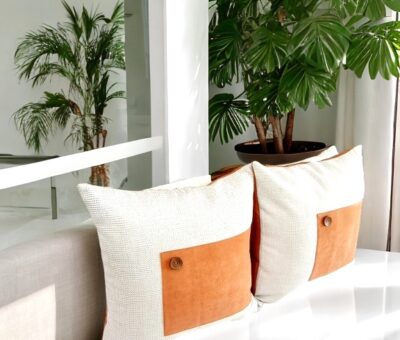Embracing Traditional Principles in a Contemporary Space
Wondering what colour is best for your living room? Or, where to place your home office desk?
Rising in popularity in 2022, Vastu Shastra – an ancient Eastern architectural science – has attracted renewed interest as a method of creating balance in homes as well as offices, enabling better places to work, rest, play and be inspired.
What is Vaastu Shastra?
Vastu means ‘under roof’ while Shastra means ‘science’. So, the term literally translates to the ‘science of building and architecture’.
Effectively, a model for organising a home or office, based on each room’s purpose and usage, all the while ensuring the different component in each room create balance and positive energy, much like Feng Shui does.
At the core of the theory are five elements – earth, fire, water, wood and metal. Each connected to a specific colour pallet and shape. For example, the colour of fire is red, with a triangle, the obvious shape.
To reach the maximum level of positive energy in a home or office, all the components should be in balance, considering the influence of a building’s directional orientation. When components clash, imbalances are believed to occur, manifesting in a destructive manner.
While Vastu includes advice and guidelines for homes and offices, the art has also been incorporated in the building of cities, gardens, roads and other large public areas across the world. Right here in South Africa, Vastu has been integrated with modern, western architecture in the design of many prestigious estates such as Steyn City, Eye of Africa, Waterfall and Copperleaf, to name but a few.
While it’s not always possible to reposition doors and windows to please Vastu; it is not essential for creating functional as well as aesthetically pleasing spaces, we are of the opinion that incorporating some of the Vastu Shastra principles can result in homes and commercial spaces that resonate with prosperity and harmony.
1. Vastu tips for the Master Bedroom:
The master bedroom is the most personal space in your home and your haven of privacy and total relaxation. It is fair then that Vaastu gives it high priority and significance.
Vastu recommends:
- Sleeping with your head towards the South or East direction as it enhances sound sleep, good health and longevity
- Keeping the centre point of the room empty and clean (if space allows)
- Making use of colours that are said to have a harmonious aura, such as white, grey, green, rose, blue and brown
- Trying to avoid mirrors and the usage of electronic appliances as it takes away the room’s coherence
We chose soothing shades of green (wood element) as the dominant colour for this Master Bedroom as it is believed to enhance the feeling of being grounded while representing fertility and healing; and can transcend a sense of calmness and security, when used in interior design. The colour pairs naturally with brown (as it is commonly seen together in nature) making terracotta and wood the perfect accents to add vibrance and balance to this room.
2. Vastu tips for the Dining Room
The well-known expression “A family who eats together, stays together”, emphasize the significance of the dining room.
Considering it’s the room where loved ones share meals and are entertained, Vastu believes it to be sacred, with the dining table a symbol of health, nourishment and bonding. For this reason, focus is placed on creating a welcoming and comfortable space that radiates a positive ambiance by:
- Positioning the dining room on the South, West or Eastern side of the house (if possible), either autonomous or in continuation with the kitchen
- Decluttering the space of unwanted objects by featuring a simple bowl of fruits or other food items, which is believed to attract prosperity
- Stimulating the appetite by making use of colours like yellow, saffron, peach, orange or red
In this otherwise neutral dining room, we chose red and orange accents that symbolize passion, vitality, and communication. A rich, red rug makes the dining area feel like a destination in this large, open plan living area, while the colour palette was applied in moderation to the wall art and chair upholstery. As these vibrant colours represent the element of fire and is believed to stimulate aggression (when used excessively) we chose to combine it with calming colour tones like white and beige, to balance the human emotion.
3. Vastu tips for the Home Office
People often try ensure their offices adhere to Vastu guidelines and usher in good luck and fortune. From maintaining cash flow to business stability, it is believed these design principles can bring forth financial prosperity and holistic well-being, both at home and at the workplace. We share some basic Vastu guidelines you can follow at your home office:
- Entrepreneurs should sit facing East or North (or North-East) as the sun rises in the East, making it conducive for new beginnings and financial growth.
- The entrance of the office (or home office) should be in the North as the direction is known as that of the god of wealth, aiding the acceleration of financial profits. Should your entrance be in the “wrong” position, Vastu recommends making use of metals to ward off any negative energy.
- Ensure the office has ample natural light, as sunlight is associated with positive energy. Adequate levels of lighting will also aid concentration.
- Keep desks clutter-free and throw away broken stationery as it acts as an obstacle to financial prosperity.
- Use bright colours like blue, green, red, pink, yellow or white, for the wall paint and décor as it spreads positivity and reflects light.
- Introduce plants that are believed to bring good luck, like bamboo or lilies.
Introducing an unexpected bold splash of colour by way of a deep yellow (earth element) accent wall makes all the difference between a snoozy workspace and one that is energized, with its cheerful disposition and lively character. Said to attract prosperity, we created a statement-worthy backdrop for this home-based office, helping separate the workplace from the rest of the open plan area and adding an element of interest to a clean, minimalistic nook.
4. Vastu tips for the Lounge
The living room is always the centre of the house – the first place that welcomes you home, the most used place when guests come over or the place where you spend most of your quality time with your loved ones. To aid fostering of healthy relationships, you can create an inviting and homely living space by following these Vastu tips:
- Avoid using black or red colours on the walls. Rather opt for neutrals like white, cream and beige; or shades of blue, green and warm yellow, which is believed to trap positive energy in the lounge.
- Incorporate artwork that display the beauty of nature and avoid using dried or artificial flowers, bonsai or cacti in the living room as it is deemed inauspicious.
- Remove non-working clocks, broken showpieces, or electrical appliances, cracked glass and so on.
In this pajama lounge, which also serves as a reading room, we choose a soothing blue colour pallet (water element) that is associated with tranquility and serenity. The colour blue is also said to promote clarity of mind; and strikes a beautiful contract with the white walls and oversized couch, which represents peace.
Does Vastu Shastra work?
While the science of spatial energy remains a complicated and dynamic one, we believe a well-ordered home brings peace and clarity to any household.
Home is a place where memories are formed. By respecting your home and keeping it organised and clear of clutter, you are bound to invite positive energy into your space, thereby fostering joy and abundance in many beautiful ways.
Contact: DIY Girls






























